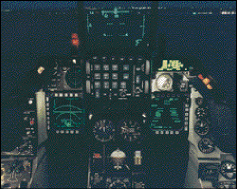Daniel C. McCarthy, News Editor
The F-16 Flying Falcon, widely regarded as the world's most versatile military aircraft, owes some of its acclaim to the pilot's head-up display, which delivers real-time information about target location, navigation and weapons systems through virtual imagery within the pilot's line of sight. The intensity of this virtual imagery automatically adjusts to appear brighter in daylight and dimmer at night. To increase the speed, mobility and repeatability of display maintenance, the US Air Force is using a photometer-linked theodolite system developed by Marconi North America's GDE Systems Inc. and by Gamma Scientific Inc.

Head-up displays in the F-16 Flying Falcon show target location, navigation and weapons systems data focused at infinity to appear within the pilot's line of vision. The US Air Force is using a photometer-linked theodolite system to increase the speed, mobility and repeatability of display maintenance. Courtesy of GDE Systems Inc.
The projection of head-up display imagery into virtual space complicates analysis of the symbology. The display projects data focused at infinity to a design eye box that is large enough to accommodate the physical statures of different pilots. When the pilot's eyes are in this eye box area and are focused to infinity, the data appear in his field of vision. Because the data are focused to infinity, the only way to measure their intensity, contrast ratios, resolution and location is by angular measurement; hence, the need for a theodolite.
Prior to the new system, the measurements taken with an unintegrated theodolite and photometer were prone to variances between the two instruments or between two people using them.
"The system we developed is an integrated unit that combines the characteristics of a photometer with the accuracy of a theodolite," said Joe Stillwater, a senior design engineering specialist at GDE Systems. The incoming image from the head-up display is split so that half the light energy enters the photometer, which measures its luminance, and the other half forms an image within the theodolite, which measures position.
GDE enlisted the help of Gamma Scientific in the development and integration of the photometer component. The company was looking to improve its test station utilization and repeatability, said Tom Wolak, GDE's chief engineer for the F-16 Improved Avionics Intermediate Shop.
Gamma streamlined its photometer by using the theodolite to provide its optical pointing capability. It optically interfaces to the theodolite, which enables the photometer to be aimed at the display's symbology with accuracy. All measurement data are communicated to the test station computer. Gamma's design enabled the overall system to be made much smaller and lighter than previous systems, according to Gamma's president, Richard Austin.